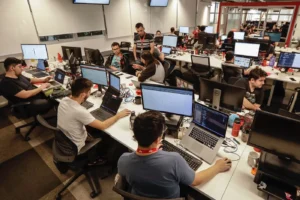Among the main challenges of urban mobility, is the search for sustainable modes (powered by clean and renewable energy) to reduce the impact of CO2 emissions on the environment. The topic is also on the agenda of iFood, which is looking for alternative solutions for its delivery operation, such as drones. The Gas Emissions and Removals Estimation System Greenhouse effect (SEEG) points out that Brazil is the 7th largest emitter of greenhouse gases in the world – some of the causes of this are industry, agriculture and transport.
“Through the iFood Regenerates – our pillar of sustainability – we make public our commitment to delivering more to the environment than we consume from it. In this way, iFood is on its way to being the first Brazilian delivery company to offer a positive environmental impact. The idea is to continue growing, but always in a responsible way”, says Gustavo Vitti, Vice-President of People at iFood.
To this end, iFood invests in research and development of technologies for sustainable modes, such as electric motorcycles, electric bikes, robots and drones. And it is about the latter that the iFood News come and tell us all the details.
The sky is the limit, but not for iFood
In April 2019, an innovation project in logistics began: delivering iFood orders with drones – a sustainable method that uses clean energy and significantly reduces the waiting time for a delivery.
After much study of what was already being done with drones around the world, combined with iFood's desire to encourage other Brazilian companies, a partnership with Speedbird Aero began. Some time later, the idea literally took off.
In August 2020, after requesting the National Civil Aviation Agency (Anac), iFood was authorized to operate two drone delivery routes in Campinas, one of the largest cities in the state of São Paulo. The initial tests were carried out in partnership with Shopping Iguatemi Campinas, where the drone traveled a route of approximately 400m, from one end of the mall to the other. If it were done by one person, the journey would take 12 minutes on average. The drone reduced this average to just 3 minutes.
In the first half of 2021, real deliveries began with the help of the modal. The order's route involved a professional who took the order to the droneporto - a specific and safe area for drone landings and takeoffs -, a Speedbird drone operator, who placed the order in the drone's transport box and operated the modal until the iFood Hub – area for delivery people to wait and receive orders from the mall's restaurants -, where another operator trained to handle the drone was waiting. After the equipment order was collected, it was directed to a delivery person, who completed the process by carrying out the last stage of delivery.
The drone used in these deliveries has capacity for orders weighing up to 2kg. It flies at 40km/h and can reach heights of up to 60 meters – the equivalent of a 20-story building. The routes are automated and are monitored by a specialist in drone operations.
In just a few months of operation, within the first half of 2021, iFood achieved the stipulated goals and delivered more than 300 real orders to consumers, with the support of more than 20 partner restaurants. For those who had doubts, the future has already arrived.
The plans, however, do not stop there. The sky of other cities is already in iFood's intentions.
Next steps
“We mapped at least 200 cities where iFood is present with conditions similar to those in Campinas to test the implementation of drones as complementary delivery modes. In fact, a capital in the Northeast is already in our plans”, reveals Fernando Martins.
The intentions to expand the drone as a modal for food delivery are directly linked to the iFood Regenera commitments. By 2025, the goal is to make at least 50% of iFood deliveries using non-polluting modes.


